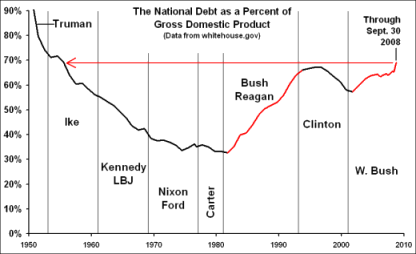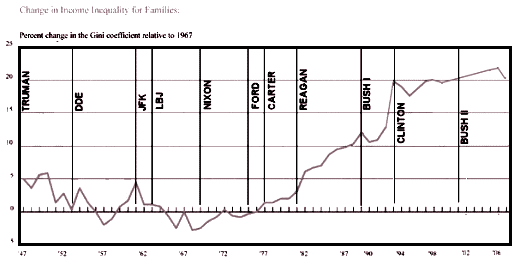I wanted to share this graph with you. It’s not dispositive of any specific questions in itself. But it’s a valuable set of data for evaluating the question we’ve been discussing in many posts today — the relative size of the financial sector relative to the rest of the economy.

The graph comes from an article by Simon Johnson in the current issue of The Atlantic, ‘The Quiet Coup‘, which I strongly recommend.
The text is a little small. So the first graph shows financial sector profits as a percentage of US business profits going back to the end of World War II. The second charts income per worker in the financial sector as a percentage of average compensation across the economy. As you can see, the pivot in each case is around 1980.
The number that jumps out at me is that at that peak point upwards of half the profits in the entire US economy was in the financial sector. And it’s been near or above a third for most of the last decade. Quite apart from the public policy implications, but rather in the realm of political economy, these graphs provide a revealing look at what the 2005 push to privatize Social Security was all about and what the implications of its success could have been…
Becoming a Banana Republic
in The Quiet CoupThe Atlantic Monthly
By Simon JohnsonIn its depth and suddenness, the U.S. economic and financial crisis is shockingly reminiscent of moments we have recently seen in emerging markets (and only in emerging markets): South Korea (1997), Malaysia (1998), Russia and Argentina (time and again). In each of those cases, global investors, afraid that the country or its financial sector wouldn’t be able to pay off mountainous debt, suddenly stopped lending. And in each case, that fear became self-fulfilling, as banks that couldn’t roll over their debt did, in fact, become unable to pay. This is precisely what drove Lehman Brothers into bankruptcy on September 15, causing all sources of funding to the U.S. financial sector to dry up overnight. Just as in emerging-market crises, the weakness in the banking system has quickly rippled out into the rest of the economy, causing a severe economic contraction and hardship for millions of people.
But there’s a deeper and more disturbing similarity: elite business interests—financiers, in the case of the U.S.—played a central role in creating the crisis, making ever-larger gambles, with the implicit backing of the government, until the inevitable collapse. More alarming, they are now using their influence to prevent precisely the sorts of reforms that are needed, and fast, to pull the economy out of its nosedive. The government seems helpless, or unwilling, to act against them.
Top investment bankers and government officials like to lay the blame for the current crisis on the lowering of U.S. interest rates after the dotcom bust or, even better—in a “buck stops somewhere else” sort of way—on the flow of savings out of China. Some on the right like to complain about Fannie Mae or Freddie Mac, or even about longer-standing efforts to promote broader homeownership. And, of course, it is axiomatic to everyone that the regulators responsible for “safety and soundness” were fast asleep at the wheel.
But these various policies—lightweight regulation, cheap money, the unwritten Chinese-American economic alliance, the promotion of homeownership—had something in common. Even though some are traditionally associated with Democrats and some with Republicans, they all benefited the financial sector. Policy changes that might have forestalled the crisis but would have limited the financial sector’s profits—such as Brooksley Born’s now-famous attempts to regulate credit-default swaps at the Commodity Futures Trading Commission, in 1998—were ignored or swept aside.
The financial industry has not always enjoyed such favored treatment. But for the past 25 years or so, finance has boomed, becoming ever more powerful. The boom began with the Reagan years, and it only gained strength with the deregulatory policies of the Clinton and George W. Bush administrations. Several other factors helped fuel the financial industry’s ascent. Paul Volcker’s monetary policy in the 1980s, and the increased volatility in interest rates that accompanied it, made bond trading much more lucrative. The invention of securitization, interest-rate swaps, and credit-default swaps greatly increased the volume of transactions that bankers could make money on. And an aging and increasingly wealthy population invested more and more money in securities, helped by the invention of the IRA and the 401(k) plan. Together, these developments vastly increased the profit opportunities in financial services.

National Debt

Wealth Inequity
Sorry, the comment form is closed at this time.